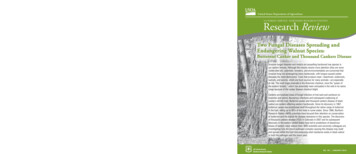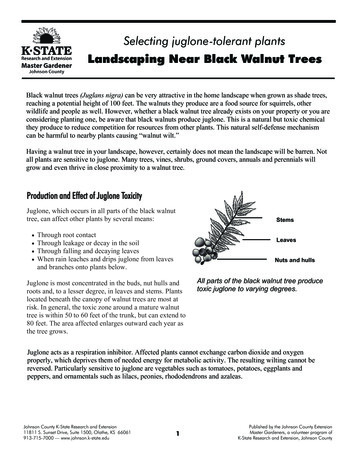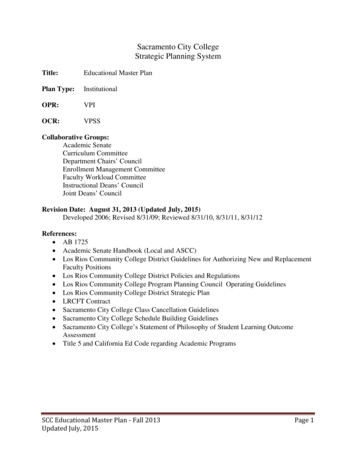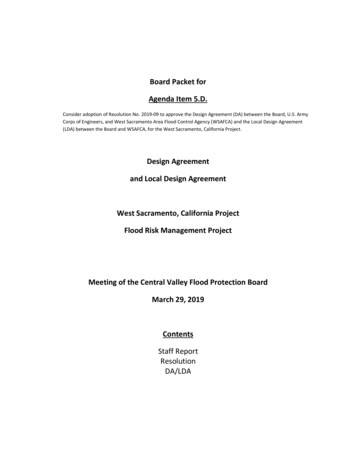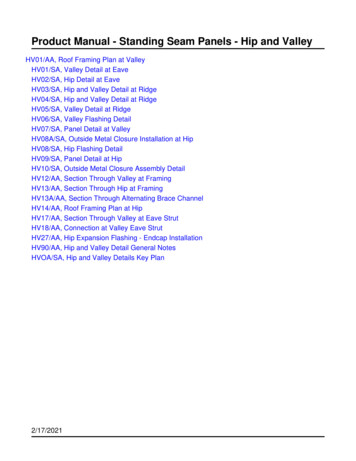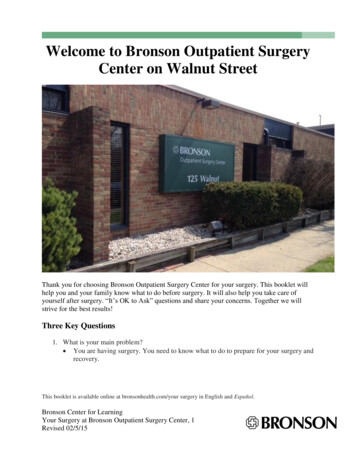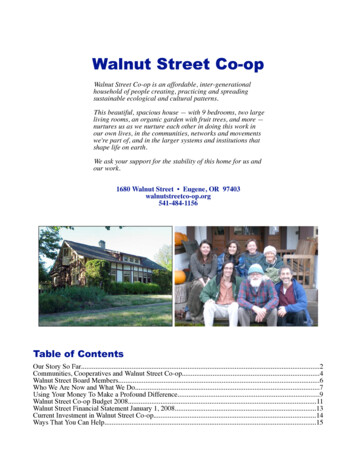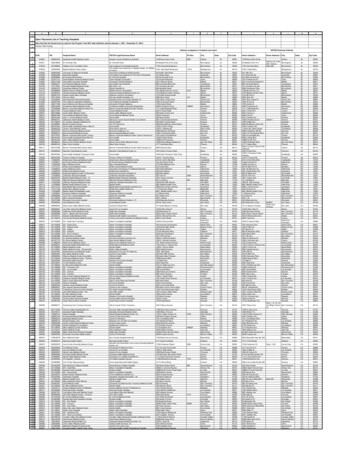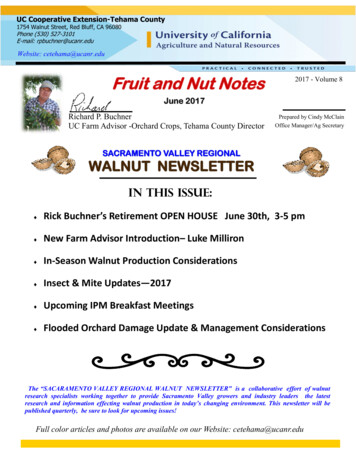
Transcription
UC Cooperative Extension-Tehama County1754 Walnut Street, Red Bluff, CA 96080Phone (530) 527-3101E-mail: rpbuchner@ucanr.eduWebsite: cetehama@ucanr.eduFruit and Nut Notes2017 - Volume 8June 2017Richard P. BuchnerUC Farm Advisor -Orchard Crops, Tehama County DirectorPrepared by Cindy McClainOffice Manager/Ag SecretarySACRAMENTO VALLEY REGIONALWALNUT NEWSLETTERIN THIS ISSUE: Rick Buchner’s Retirement OPEN HOUSE June 30th, 3-5 pm New Farm Advisor Introduction– Luke Milliron In-Season Walnut Production Considerations Insect & Mite Updates—2017 Upcoming IPM Breakfast Meetings Flooded Orchard Damage Update & Management ConsiderationsThe “SACARAMENTO VALLEY REGIONAL WALNUT NEWSLETTER” is a collaborative effort of walnutresearch specialists working together to provide Sacramento Valley growers and industry leaders the latestresearch and information effecting walnut production in today’s changing environment. This newsletter will bepublished quarterly, be sure to look for upcoming issues!Full color articles and photos are available on our Website: cetehama@ucanr.edu
Celebrating40with the Universityof California1977 to 2017s’renhcBukciR Retirementfrom the University of California 26 years with the Cooperative Extension Officein Tehama County serving as County Director for 21 years--Join us in wishing Rick a happy retirement--“OPEN HOUSE”Friday –June 30, 20173-5 pmCooperative Ag Extension Office1754 Walnut StreetFor additional information contact 527-3101
New Farm Advisor IntroductionLuke K. Milliron, UCCE Farm Advisor Butte, Glenn, and Tehama CountiesI am ecstatic to be working as the UC Cooperative Extension (UCCE) orchard systems Farm Advisor forButte, Glenn, and Tehama Counties. I am based out of theButte County Cooperative Extension Office in Oroville. Igrew up in Chico and studied Crop Science at Butte Collegeand Chico State. While attending Chico State, I worked asa Student Assistant to Tree Crop Farm Advisor BillKrueger, out of the Glenn County Cooperative Extensionoffice.In 2013 I left Chico to pursue a Master of Science degreein Horticulture and Agronomy at UC Davis. While at UCDavis in the midst of drought in California, I studied themeasurement of almond tree water stress during dormancy. In 2015, I was selected as the UCCE Horticulture Intern, an internship program funded by theAlmond Board of California and the California Dried Plum Board aimed at training the next generationfor UC Cooperative Extension. As part of the internship I contributed to UC Cooperative Extensionwalnut production research in Sutter and Yuba Counties with Farm Advisor Janine Hasey.I have most recently been working as an Agronomy Technician at Dellavalle Laboratory, Inc. in Davis. AtDellavalle, I worked for the past year to assist growers with analytic crop nutrient managementthrough soil and plant tissue sampling and irrigation management support in almond, walnut, grapevineand processing tomato systems. At each step in my journey I have greatly enjoyed working with growers and other agriculture professionals. I am humbled and very excited to work as your walnut farm advisor. I encourage you to contact me by sending me an e-mail at lkmilliron@ucanr.edu, giving me a call at(530) 538-7201 or stopping by the office at 2279-B Del Oro Avenue in Oroville.Curious about what your farm advisors are seeing in the orchards?Check out the ‘Photos from the Field’ feature on our website /.
In-Season Walnut Production ConsiderationsKatherine Pope, UCCE Orchard Advisor Yolo, Solano, & Sacramento Cos.JUNEWalnut Husk Fly (WHF) traps should already be out, 2 traps for every 10 acres on the north side of the tree,hung as high as possible. Monitor traps at least twice weekly until first treatment. Treatment timing can bebased on when females with eggs are found, or simply when trap catches increase sharply. For more onmonitoring and treatment, see the Sac Valley Orchards article at https://goo.gl/LTcL6K.If only applying one Bot canker and blight fungicide spray, the second part of June to first part of July had themost effect in recent UC trials, when tested in both a low and high disease situation. For more on timing, seethe Sac Valley Orchards Bot article at goo.gl/8aCxNA.JULYCodling moth third flight occurs in late July to early August (on average, 1100 Degree Days after the secondbiofix). Check traps to look for the third flight. Treatment decision is based on a combination of factorsincluding previous treatments, number of nuts infested in the previous generation, trap catches, and the abilityto harvest early. See ipm.ucanr.edu/PMG/r881300211.html for more details.Monitor weekly for WHF. If spray residue from the previous spray has run out, harvest is more than 3 weeksaway and eggs are present in trapped females, an additional treatment may be prudent. For more, seeipm.ucanr.edu/PMG/r881301211.html.Take July leaf samples to assess nitrogen, as well as potentially potassium and zinc deficiencies, and borontoxicity, depending on your circumstances. Sample a total of about 60 terminal leaflets from at least 16 treeson the same rootstock scattered throughout the orchard.Watch for spider mites by monitoring weekly through mid-August. Once a week, randomly select 10 trees perorchard, and from each tree take 5 leaflets from low branches and 5 leaflets from high branches. If more thanhalf the leaflets with spider mites do not also have predaceous mites, this is cause for concern. Monitor againin 3-4 days to determine if populations are increasing and treatment is warranted. For more, r ethephon as a way to increase color quality and minimize the chances of multiple shakes in a modestprice year. Ethephon application should take place when 100% of sampled nuts have reached maturity, asindicated by “packing tissue brown” (PTB). This occurs around mid-August for the earliest varieties andaround mid-September for Chandler in most years. For more on sampling to track PTB and ethephonapplication, see the Sac Valley Orchards article at https://goo.gl/PSvV8q.Monitor for Navel Orangeworm. Healthy, intact walnuts are only susceptible to NOW damage at and afterhull split. Consult with your PCA for monitoring and treatment options, bearing in mind pre-harvest intervals,duration of residual activity, and impacts of materials to your overall IPM program. See the Sac ValleyOrchards article at https://goo.gl/zhKfxw for more information.SEPTEMBERCollect a sample of at least 100 nuts at harvest for each block and freeze them. Compare them afterharvest with grade sheet to evaluate different potential sources of damage and how to improve yourIPM program for next year. For help evaluating the source of damage see photos and notes atipm.ucanr.edu/PMG/C881/m881hppests.html
Insect and Mite Updates – 2017Emily J. SymmesSacramento Valley Area IPM AdvisorThe impacts of such an unusually wet winter and prolonged spring rain events on insect and mite activity arestill developing. This article summarizes some notable observations thus far and specific pest managementconsiderations as we move into summer.The first codling moth biofix generally ranged from early- to mid-April in 2017 in the Sacramento Valley(many of the same orchards observed first biofix in late March the previous two years). As this goes to print,we are nearing 1060 degree days (DD) in most blocks and are on the lookout for the second biofix. The firstcodling moth flight this year (1A and 1B peaks) were reported to be quite high in many orchards throughoutthe region, and applications targeting one or both of these flight peaks were common. Keep in mind that agood codling moth program can help minimize early-season infestation by navel orangeworm, so keep a closeeye on your trap counts and the numbers of codling moth-infested dropped nuts in your orchards.Although wet winters can cause increased overwintering mortality of navel orangeworm, significant survivalwas apparent in walnut mummies examined this spring (March 2017). Bear in mind that your neighbors maynot have been able to execute their normal NOW sanitation programs last winter either, and these may be asource of populations moving into your orchard as the season progresses (in addition to any carry-overpopulations you may have in your orchard). Prior to husk split, NOW will go back into mummies and into this-season’s damaged nuts (codling moth-infested and blighted nuts).Significant populations of frosted scale were evident in a number of orchards throughout the SacramentoValley this year. It is not entirely clear why this pest, which it typically present only at low levels, hasincreased so dramatically in recent years. Research is underway examining this phenomenon, as well as bestpractices and timings for effective population reduction. Frosted scale produces honeydew when feeding(walnut scale does not). This favors growth of sooty mold, which increases the chances for sunburn damage,so keep an eye on this if your orchard was heavily impacted by frosted scale this spring. Frequent rainsthroughout winter and early spring limited the ability for many growers to get into the orchards to applydormant/delayed-dormant scale treatments, necessitating applications targeting the spring crawler stage.Crawler emergence was observed late in the second week of May 2017 (compared to the first week of May2015 and last week of April 2016), with peak crawler activity noted approximately two weeks later. Thishighlights the importance of monitoring the populations, rather than applying treatments based on “typical”calendar timing (which would have been too early this year to target peak crawler activity). Our research trialsthis year are examining efficacy of different treatment materials and timings specifically for frosted scale(walnut scale has been the focus of research in recent years). If treatments were applied for frosted scale (eitherdormant/delayed-dormant or crawler), monitor the populations next dormant period looking for theoverwintering nymphs (photos and more information at ipm.ucanr.edu/PMG/r881300111.html). Frosted scalehas only one generation per year, so the effects of this season’s spray program will be best observed at thistime, and as next spring’s populations begin to develop.Conversely, walnut scale populations have dropped off in many orchards, likely due to effective managementprograms over the past few years. We observed walnut scale crawler emergence during the last week of May2017 (compared to first and second weeks of May in 2015 and 2016, respectively). Another reminder theimportance that treatment timings should be supported by field observations of pest activity each year.
Walnut husk fly traps just beginning to hit the week of June 5 in Butte and Sutter counties. No activitynoted as of that time in our trapping locations in Tehama County. Remember that WHF treatment decisionsshould be made on a site-specific basis and take the time to hang traps high in the tree canopy – this will provide better accuracy in detecting activity. If trapping indicates the presence of treatable WHF populations, allinsecticides should be applied with a bait (i.e., molasses, Nu-Lure , Monterey Insect Bait ). The exceptionis GF-120 which contains its own bait. For low- to moderate-populations, coverage is not critical and lowvolume and/or partial coverage applications (e.g., alternate row) of bait with insecticide can be effective.However, in high population orchards with extensive previous damage, high-volume, full coverage, and/ormultiple applications of bait with insecticide may be necessary to achieve adequate control. If you miss atiming and are observing fresh stings, full cover neonicotinoids that have some ovicidal (egg-killing) activitymixed with an adulticide will provide partial control of eggs if applied immediately after stings are observed.Generally, a short-residual insecticide-plus-attractant will kill walnut husk fly for 10 days. With the egg development period added to this time, there is about 3 weeks of protection after an application (GF-120 treatments often must be applied more frequently).Spider mite activity remains low at press time, but will likely begin to pick up with sustained warmer temperatures. Prophylactic May applications of abamectin, while still favored by many almond producers, haveshown to be less effective and economically-viable in most walnut orchard situations. Treatments should bebased on thresholds of spider mites and their natural enemies (particularly predator mites and sixspottedthrips). In general, the goal is to manage the ratio of predators-to-spider mites (not just spider mite numbersalone) to achieve a balance in which predators can provide free control services. Also consider the impacts ofother pesticides on spider mite and predator populations (organophosphates and pyrethroids are highly detrimental to spider mite natural enemies and often result in spider mite flare-ups). More information on treatment thresholds for mites and predators in walnuts is available at: ipm.ucanr.edu/PMG/r881400111.html.Best practices for getting the most out of your miticide in walnuts include choosing the right material for thejob (i.e., those softer on predators if they are present, desired residual activity and pre-harvest intervals,quick and effective knock-down if needed, etc.) and obtainingoptimal coverage (high volume, slowspeed).Upcoming IPMBreakfast MeetingsJoin Area IPM and Farm Advisors to discusscurrentpest management and production issues. Wewill largely focus on orchard crops (but everything is on the table for discussion!). These meetings are open toall interested growers, consultants, PCAs, CCAs, and related industry.Meetings will be held the second Tuesday of each month from February through November and will cover awide range of timely pest and orchard management topics. Meeting locations will be rotated throughout the Sacramento Valley each month. Please contact Emily Symmes to request topics or bring your questions to the meeting!Upcoming meetings:Colusa: July 11th (Location TBA)Yuba-Sutter: August 8th (Perko’s Restaurant)Tehama: September 12th (Rockin R Restaurant)Glenn: October 10th (Berry Patch Restaurant)Butte: November 14th (Location TBA)Additional information for each meeting will be available on the events page at sacvalleyorchards.com or bycontacting UC IPM Advisor Emily Symmes at (530) 538-7201 or ejsymmes@ucanr.edu.**DPR and CCA Continuing Education hours requested**
Flooded Orchard Damage Update and Management ConsiderationsJanine Hasey, UCCE Farm Advisor, Sutter/Yuba/Colusa CountiesGreg Browne, USDA Plant Pathologist, UC DavisAstrid Volder, Plant Sciences, UC DavisIn 2017, high and fluctuating water flows, unprecedented for their duration, passed through the Sacramento andFeather Rivers. Orchards were hurt by these flows due to direct flooding, indirect flooding via under-leveeseepage, and loss of land through river bank erosion. Many orchards had standing water from January throughmid-May. In other orchards, ditches overflowed with nowhere to pump water out. Unlike previous years wherefloods occurred from levee breaks, such as 1986 and 1997, trees in 2017 had a much longer exposure towaterlogged conditions. This article details our observations on flooded orchard damage as of early June,research plans, management considerations, and an update on potential resources available for flood damagedorchards. For details on flooding damage generalities and past flood events, please see our article in the 2017spring newsletter issue, which can be viewed in 3 parts at www.sacvalleyorchards.com/walnuts.Thoughts and Observations to DateBy early June 2017, many flooded or waterlogged walnut and peach orchards exhibited tree death or severedecline, but assessing losses should be delayed until the end of summer when the extent of damage will beclearer. There may also be effects seen next year and subsequent years. Since peach trees start blooming in late February and are very sensitive to wet conditions, the first peach treedamage was noticed in late March/early April. Walnut root activity begins in later spring, with waterloggingsymptoms appearing in early May. Some peach and walnut trees had healthy crowns and roots in the top foot of soil even though they wereleafing out late or had leafed out and died back. These symptoms were caused by waterlogging of deeper rootswhere soils were still saturated. In previous years, flooded trees usually had dead crown tissue and rot ofshallow roots from waterlogging and/or Phytophthora. In early April, after a peach orchard on heavier soil bloomed and started to leaf out, shoots began to die(Photo 1). However, some buds (mainly on larger limbs) tried to push. Once the soil dried out, the trees began torecover (Photo 2). This illustrates why it is best to wait and leave trees through the summer to more fullyevaluate potential recovery. Preliminary results show Phytophthora in several locations where we sampled surface water. In river bottoms where walnut trees were partially submerged for prolonged periods, we isolatedPhytophthora species from bleeding root and aerial trunk cankers first noticed around mid-May (Photos 3 & 4). In a young Chandler orchard on RX1 rootstock, a third of the orchard had seepage from January to earlyMay, whereby only the tops of the berms were not submerged. Flooded trees leafed out about a month later thanthose not flooded. Some trees are struggling while others are continuing to leaf out and grow (Photos 5 & 6). Research PlansOur approach is to study two potential problems of concern: 1) diseases caused by Phytophthora and 2) impactof waterlogging on the root system. We know the “water mold” Phytophthora is found in surface water and infested soils. In May, we sampledwater in the Sacramento and Feather Rivers, in swales of standing flood water in the Feather River bottoms(Photo 7), and in seepage water from under levees along both rivers for the presence of Phytophthora. We sampled several walnut trees with symptoms of aerial Phytophthora and examined the crown and upperroots on declining trees. We will monitor these sites through the summer and backhoe trees to examine rootsystems. We will study the impact of long-term flooding from continued seepage on walnut root health and tree waterstatus.
Management Considerations Flooded orchards will likely respond to irrigation differently than normal, since root systems arecompromised. In saturated soils, fine roots die, and depending on the extent of flooding, larger roots can die as well.It takes time for the root system to regain functionality and re-start new fine root production afterflooding. If the water table level below the soil surface drops gradually, trees may be able to continue to producefunctional roots at increasingly deeper levels over time. Initial irrigation could be delayed for sometime, as deeper roots may maintain water uptake. However, if the soil remains saturated at some level below the surface, the only functional roots maybe at a very shallow depth and irrigation may have to be initiated earlier than normal. In this case,shorter but more frequent irrigations could help avoid further damage to roots in the upper zone. Carefully monitor both soil water levels and tree water status so that the trees can be graduallybrought back to health. Soil based monitoring, using Watermark soil moisture sensors installed atdifferent depths, will let you know the level where the soil is saturated as the water level drops, aswell as the amount of water that is being moved up above this level of saturation by capillary rise.Apply enough water to bring the soil to field capacity to enable plant water uptake from the uppersoil, but avoid prolonged periods of saturation that may damage roots. It is easy to saturate the soil,particularly when the water table is close, so irrigate judiciously, ideally using both soil moisturemonitoring and plant pressure chamber data to aid in determining irrigation duration and frequency. Do not initiate irrigation until pressure chamber measurements show trees are 2-3 bars below the fullywatered baseline (more dry) and only irrigate enough to bring the trees back up to about 0.5 to 1 barbelow the baseline by applying short sets of irrigation. It is not a good idea to prune or fertilize trees after flooding. Pruning will reduce both carbohydratereserves and leaf area, while fertilizer applications may mostly go to waste and delay or damage rootproduction. The best approach would be to wait, and let the tree adjust to the altered environmentalconditions while managing irrigation as described above to avoid further damage to the root system.Potential Resources for Orchards Damaged by FloodingWe still don’t know fully which programs are available and who will qualify for what programs. For morecomplete summaries of the resources available below and how to report tree damage s-blog/resources-for-flooded-orchards/Farm Service Agency (FSA)All the programs available through the FSA can be accessed at https://www.fsa.usda.gov/Contact your local office for program details and deadlines to qualify. Note that to qualify forFSA programs, dead trees from 2017 flooding/seepage need to be left in orchards for lossassessments that will be conducted later this summer.Tree Assistance Program (TAP)h t t ps : / / w w w . f s a . us da . go v / A s s e t s/ U S D A - F S A - P u b l i c / u sd a f i l e s / F a c t S h e e t s / 2 0 1 5/tap fact sheet oct 2015.pdfThe TAP provides financial assistance to eligible nursery and tree crop growers to rehabilitate orreplant eligible trees or vines lost by natural disasters. To qualify, there must be more than 18%(15% normal 3%) mortality loss in an orchard block. Final date to submit an application andsupporting documentation is 90 days after the disaster event or the date when the loss isapparent.
Emergency Loan AssistanceA program which provides emergency loans to help cover production and physical losses in countiesdeclared as disaster areas by the President.Emergency Conservation Program (ECP)act the respective office if you have land in Butte or Tehama counties.ationProgramTehama County and Butte County FSA offices are waiting to hear final approval for the EmergencyConservation Program. This program may help assist with debris removal, releveling or grading, andrestoring irrigation systems. Contact the respective office if you have land in Butte or Tehamacounties. This program will not apply to orchards inside the levees.County AssessorThe Revenue and Taxation Code allows reassessment of property damaged by misfortune or calamity. Ifthere is at least 10,000 worth of losses of tree value currently on the tax roll, you can obtain a claimform from the Assessor’s office.Tree loss calculators based on UCCE cost studies through Agricultural & Resource Economics at UCDavis.When an individual tree or vine is destroyed in an orchard or vineyard due to natural causes, vehicleaccident, shaker damage, or other causes such as flooding, the link below provides workbooks onspecific crops to calculate the value of a single tree or vine lost to any cause taking into account theloss of future income. There are two worksheet versions: "With Replanting" and "WithoutReplanting”. to 1. Peach collapse from waterlogging taken April 5, 2017.Photo 2. Same orchard on June 1, 2017with new shoot growth after soil dried
Photos 3 & 4. Bleeding cankers associated with aerial Phytophthora on a river bottom walnut tree (taken onMay 23, 2017).
Photos 5 & 6. Late leaf out of waterlogged Chandler on RX1 rootstock. The tree on the right appears to berecovering as soil dries out (taken on May 23, 2017).Photo 7. Walnut in foreground collapsed in a swale of flood water thatwe sampled (background) in the riverbottom (taken on May 23, 2017). Allphotos taken by Janine Hasey.
SACRAMENTO VALLEY REGIONALWALNUT NEWSLETTERANR NONDISCRIMINATION AND AFFIRMATIVE ACTION POLICY STATEMENT: The University of California, Division of Agriculture and Natural Resources (UC ANR) prohibitsdiscrimination against or harassment of any person in any of its programs or activities on the basis of race, color, national origin, religion, sex, gender, gender expression, gender identity, pregnancy (which includes pregnancy, childbirth, and medical conditions related to pregnancy or childbirth), ph ysical or mental disability, medical condition (cancer-related or genetic characteristics), genetic information (including family medical history), ancestry, marital status, age, sexual orientation, citizenship, status as a protectedveteran or service in the uniformed services (as defined by the Uniformed Services Employment and Reemployment Rights Act of 1994 [USERRA]), as well as state military andnaval service.UC ANR policy prohibits retaliation against any employee or person in any of its programs or activities for bringing a complaint of discrimination or harassment. UC ANR policyalso prohibits retaliation against a person who assists someone with a complaint of discrimination or harassment, or participates in any manner in an investigation or resolutionof a complaint of discrimination or harassment. Retaliation includes threats, intimidation, reprisals, and/or adverse actions related to any of its programs or activities.UC ANR is an Equal Opportunity/Affirmative Action Employer. All qualified applicants will receive consideration for employment and/or participation in any of its programs oractivities without regard to race, color, religion, sex, national origin, disability, age or protected veteran status.University policy is intended to be consistent with the provisions of applicable State and Federal laws.Inquiries regarding the University’s equal employment opportunity policies may be directed to: Linda Marie Manton, Affirmative Action Contact and Title IX Officer, Universityof California, Agriculture and Natural Resources, 2801 Second Street, Davis, CA 95618, (530) 750-1318.Email: lmmanton@ucanr.eduWebsite: ive Action/.This policy statement supersedes the UC ANR Nondiscrimination and Affirmative Action Policy Statement for University of California Publications Regarding Program Practices dated July 2013.To simplify information, trade names of products may have been used but no endorsement of named product is intended, nor is criticism implied of similar products, which are not mentioned.Cooperative ExtensionUniversity of California1754Walnut StreetRed Bluff, CA 96080“52”PRSRT STDUS POSTAGEPaidRed BluffPermit No. 112
grew up in Chico and studied Crop Science at Butte College and Chico State. While attending Chico State, I worked as a Student Assistant to Tree Crop Farm Advisor Bill Krueger, out of the Glenn County Cooperative Extension office. In 2013 I left Chico to pursue a Master of Science degree in Horticulture and Agronomy at UC Davis.
